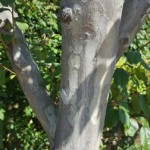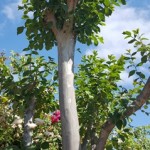Transplanting a Decades-Old Crape Myrtle Tree
Friends said it was a bad idea. The tree was too large, too old, and too unwieldy to dig up and transport from my daughter’s property to mine. The crape myrtle would not survive, they told me, because its large root would need to be severely cut. Also, without a crane or other lifting device, three of us would be struggling to deal with such a heavy tree.
I won’t say moving the tree was easy. It had been standing for 28 years next to my daughter’s house, but she wanted to make way for new landscaping. When the family decided to part with the tree, they called on a family friend who worked as an arborist. He would do the cutting and digging of the tree.
Crape myrtles (of the genus, lagerstoemia) are available as shrubs and trees and are lovely in bloom with showy paniculate flowers in pink, fuchsia, red, or lavender. They are one of the trees that make little-to-no pollen (great for allergy sufferers). Light pruning during the growing season can produce a second bloom. Much beloved in the deep south, these trees remain stately and beautiful for up to fifty years.
My daughter’s tree arrived at the farmette in mid-October strapped onto our friend’s truck. The roots had been cut away. There were no fine root hairs or stems left–just bare wood. Ditto for the tree canopy–just a few hefty branch stubs. I wondered if our efforts would prove futile.
Hubby and I prepared a large planting hole just off from the patio. We added amendments to the clay soil and drove in stakes to keep the tree stable for a year or more until it had sufficiently developed roots. I added root hormone to the soil and watered deeply the first day and several times that week.
The winter rains came. I watched, waited, and wondered if there would ever be sprouting of any kind on the woody ends where branches had been amputated. Despite a canopy, the tree’s trunk, a beautiful, gray-green wood, afforded a kind of beauty to the austere winter garden. Before spring, I scraped a fingernail on the back of the trunk and discovered the wood was not dried out but as green and moist as a young sapling.
A spell of warm weather and the buzzing of bees in early spring drew my attention upward. Our tree had sprouted a flurry of bronze-green leaves. Pink blooms will likely appear in June or July.
I’m happy now that we went to all the trouble of bringing that tree onto the farmette for transplanting. We’ll have lovely pink blooms over the remaining summers of my life thanks to the crape myrtle tree being so long-lived.
__________________________________________________________________
If you enjoy reading about gardening and farming topics, check out my Henny Penny Farmette series of mysteries: A BEELINE TO MURDER, THE MURDER OF A QUEEN BEE, and A HIVE OF HOMICIDES (Kensington Publishing).
Each book is chocked full of tips for gardening, keeping bees and chickens, and growing heirloom fruits and vegetables. There are also plenty of delicious recipes to try. Find these books on Amazon.com, Barnes & Noble.com, Walmart.com and other online retailers or purchase at traditional bookstores everywhere.–Meera Lester
 Facebook
Facebook Goodreads
Goodreads LinkedIn
LinkedIn Meera Lester
Meera Lester Twitter
Twitter







